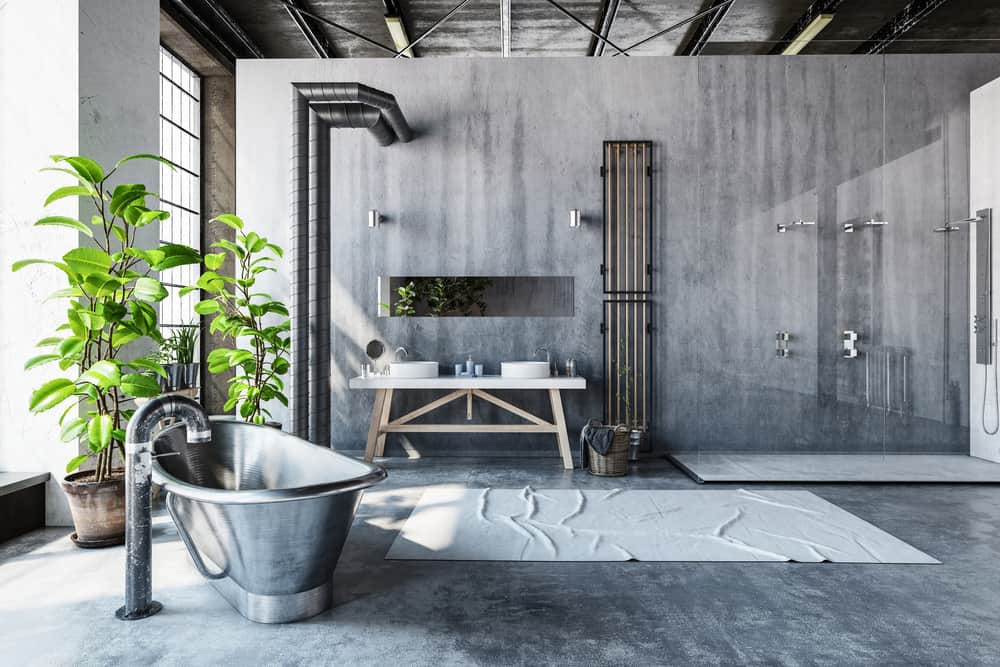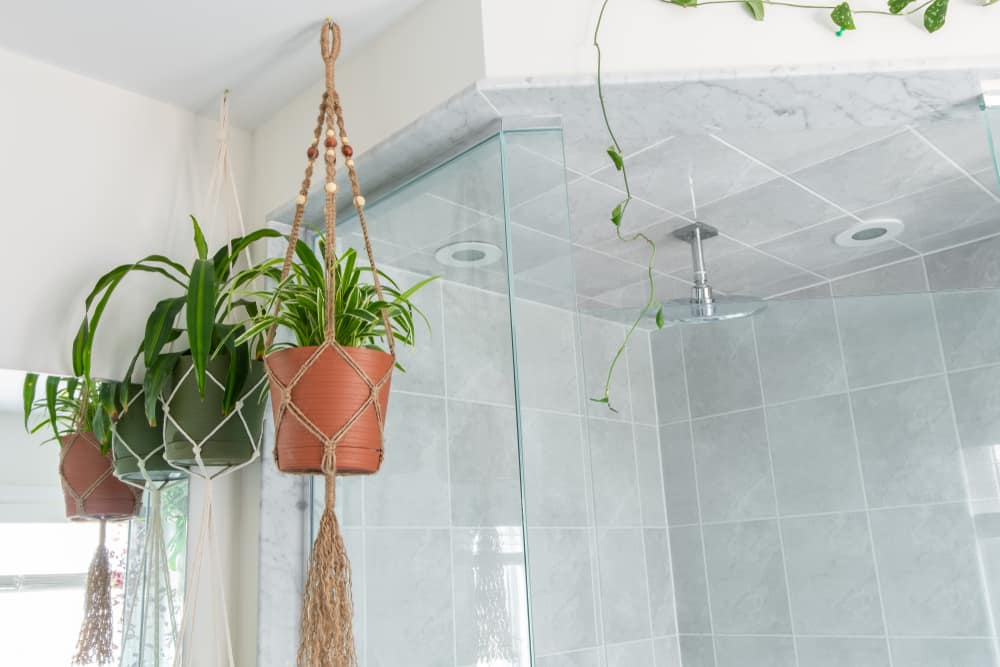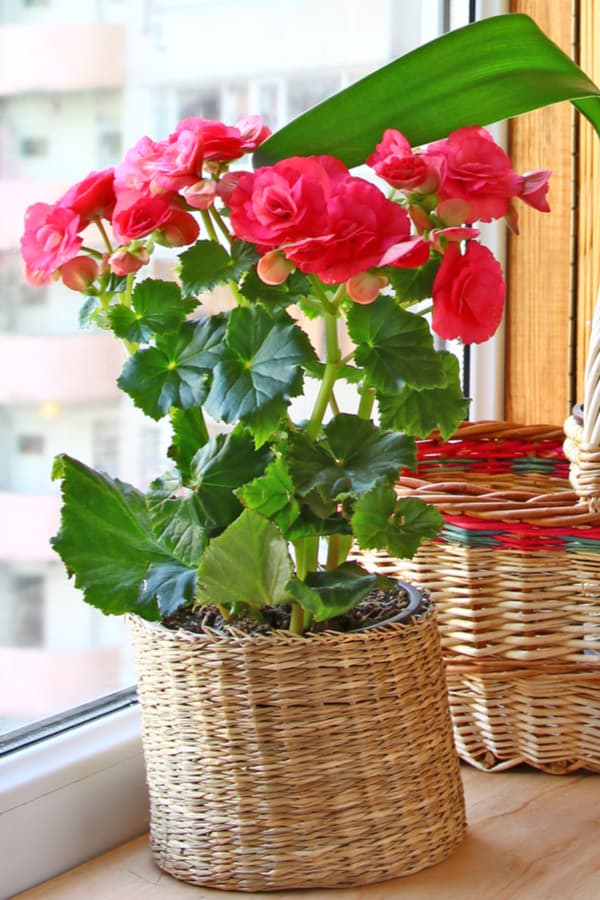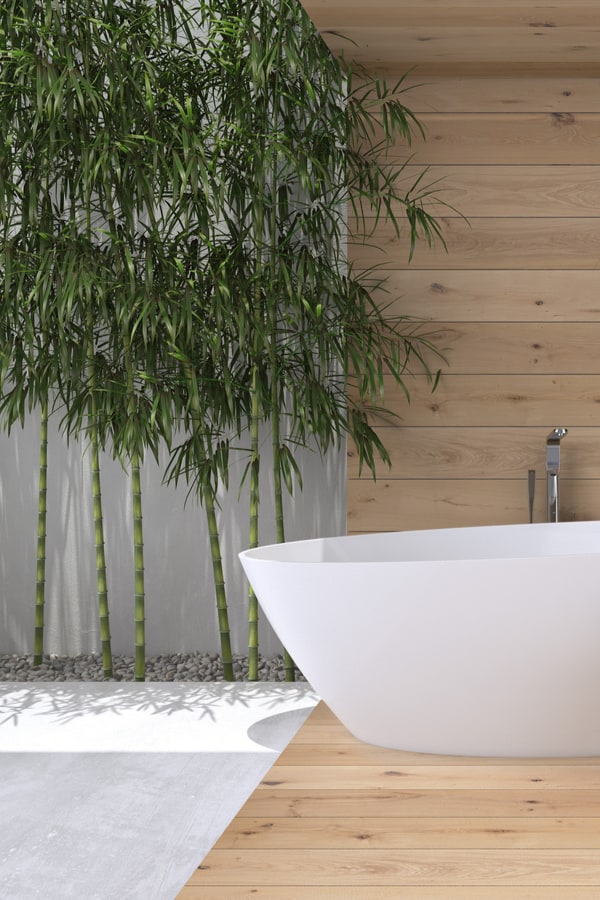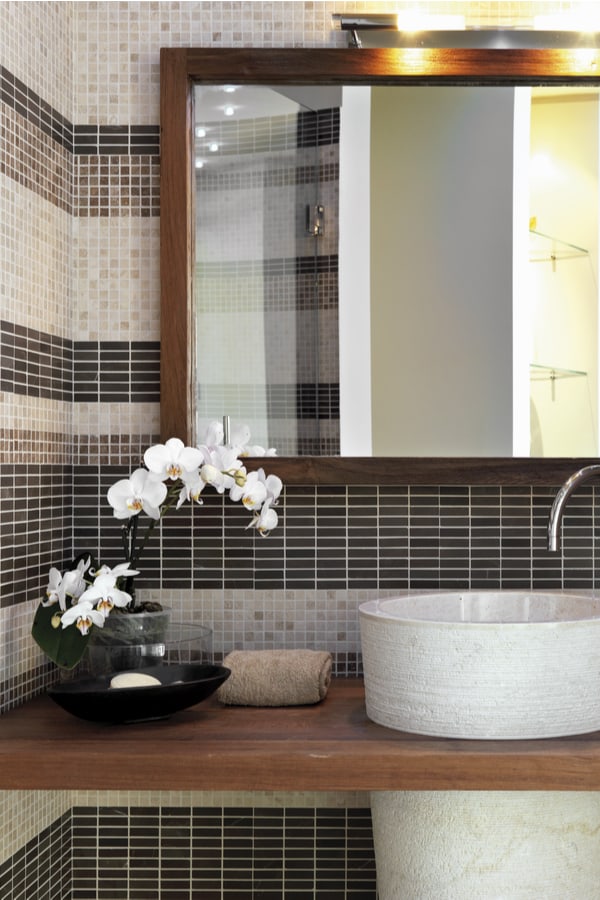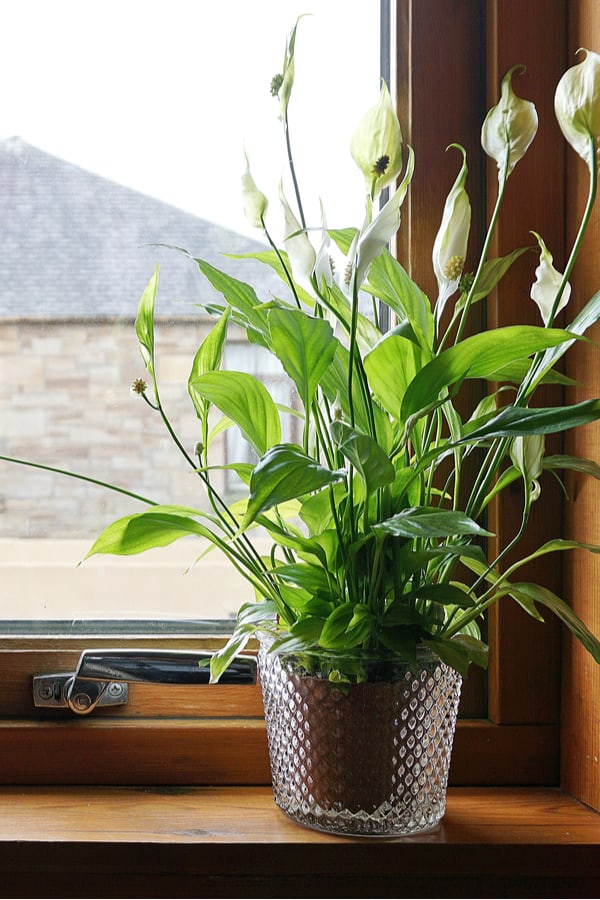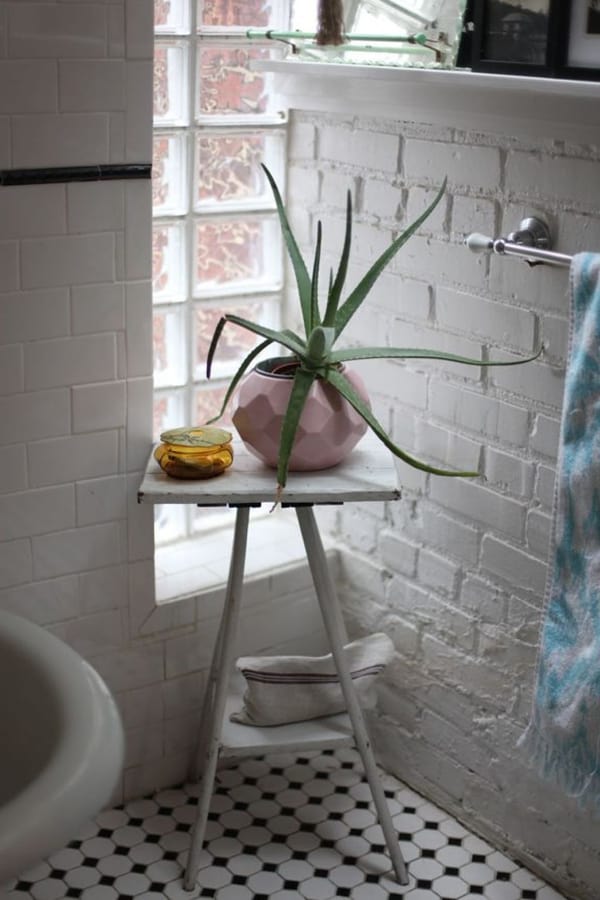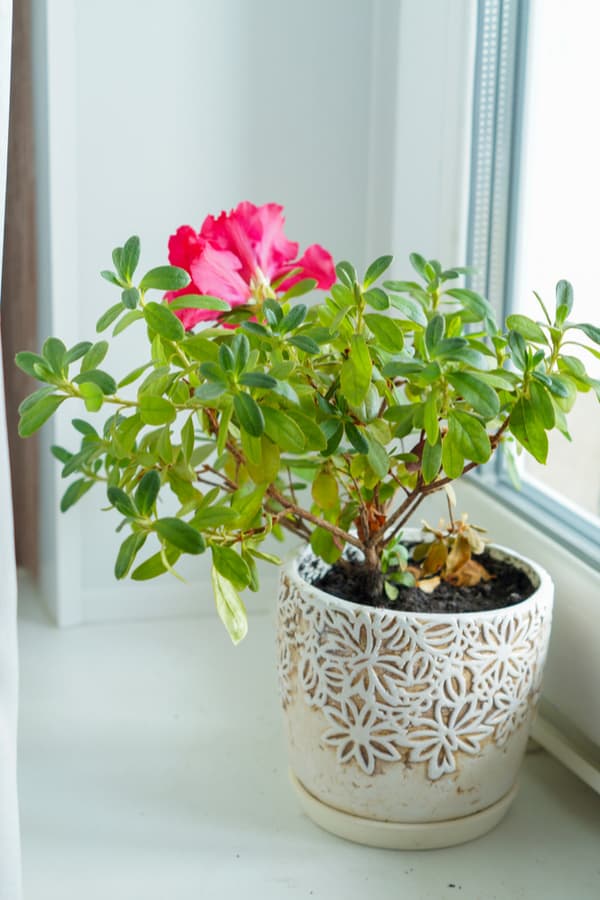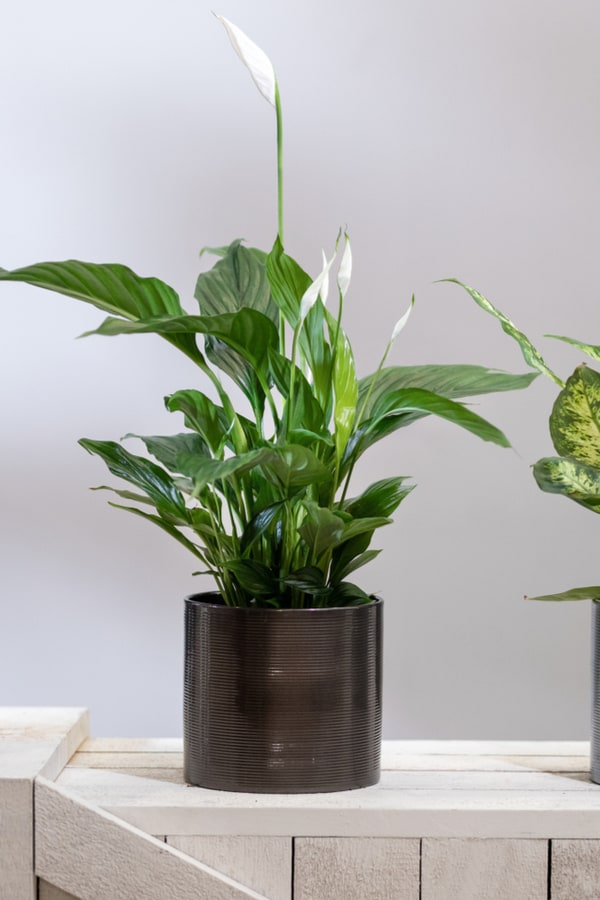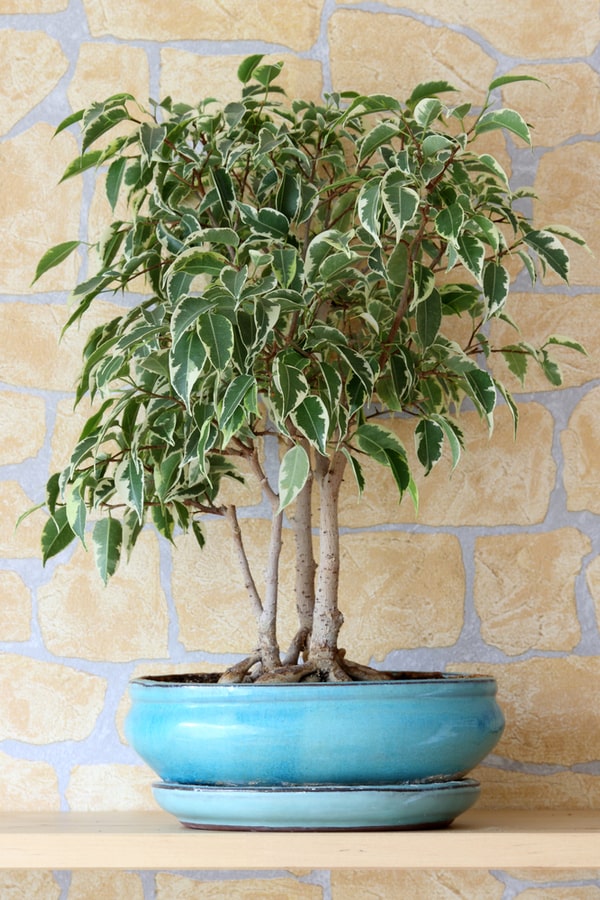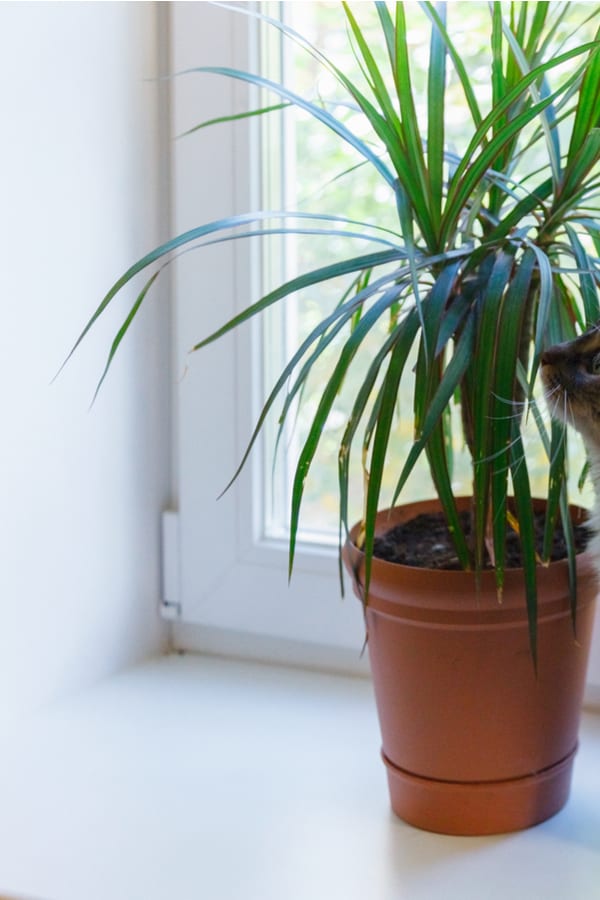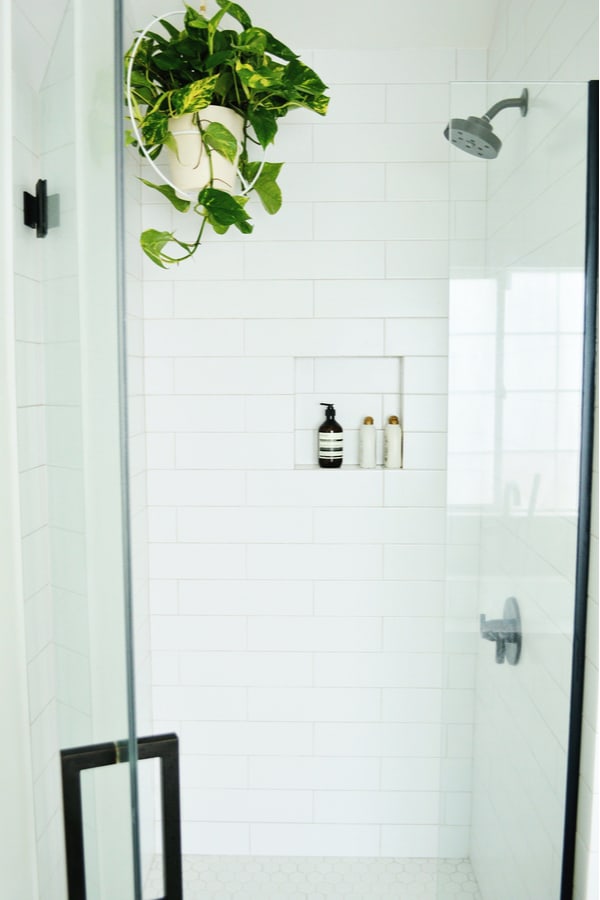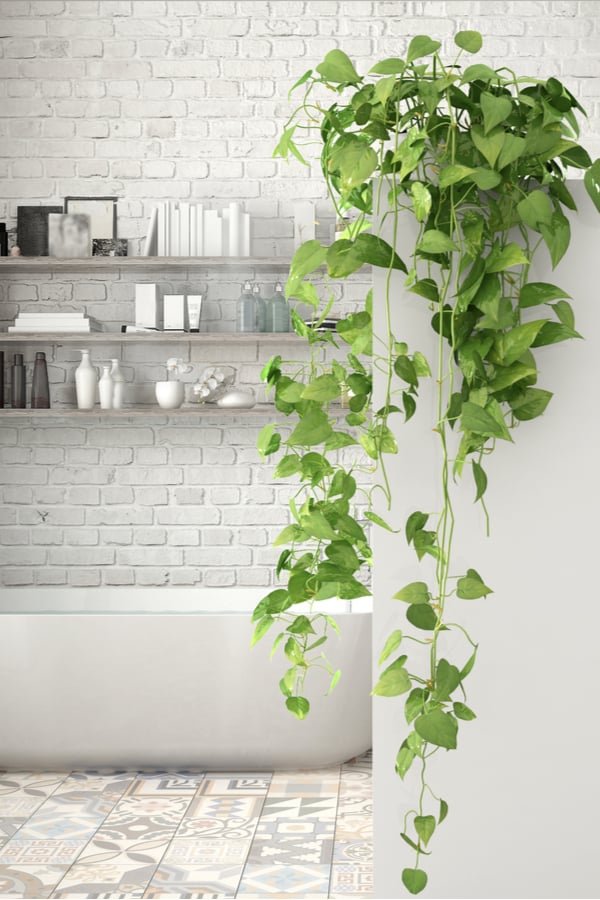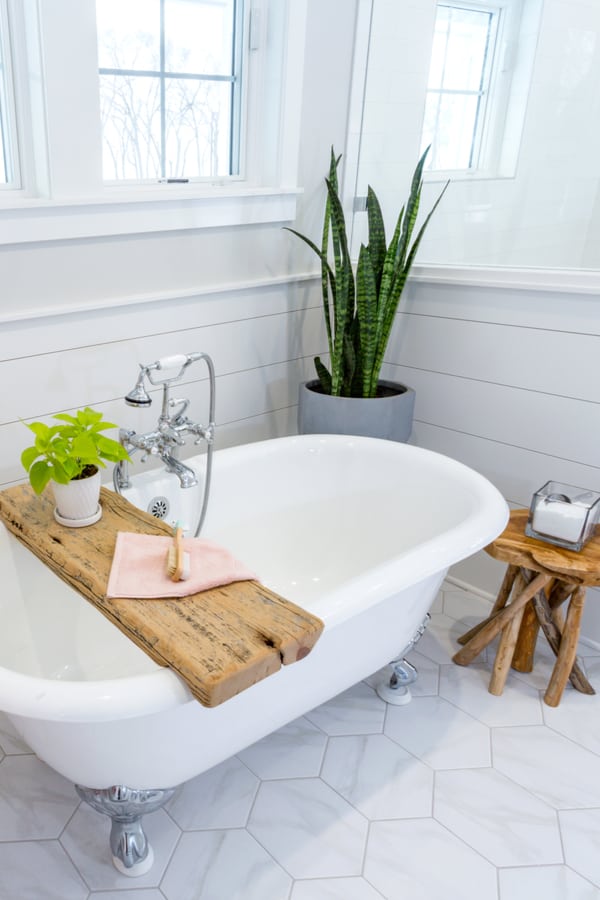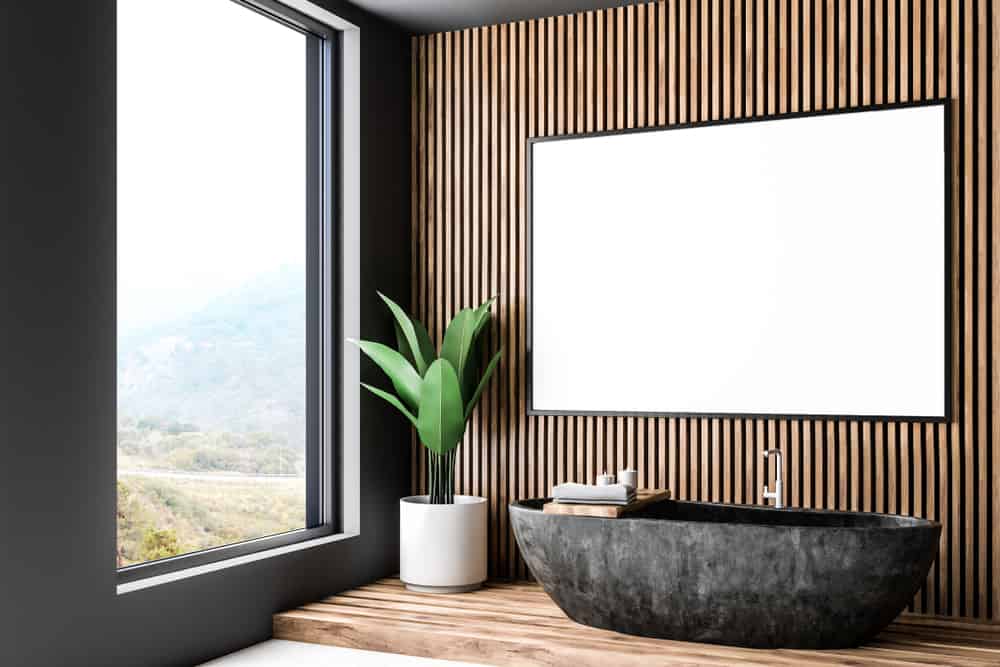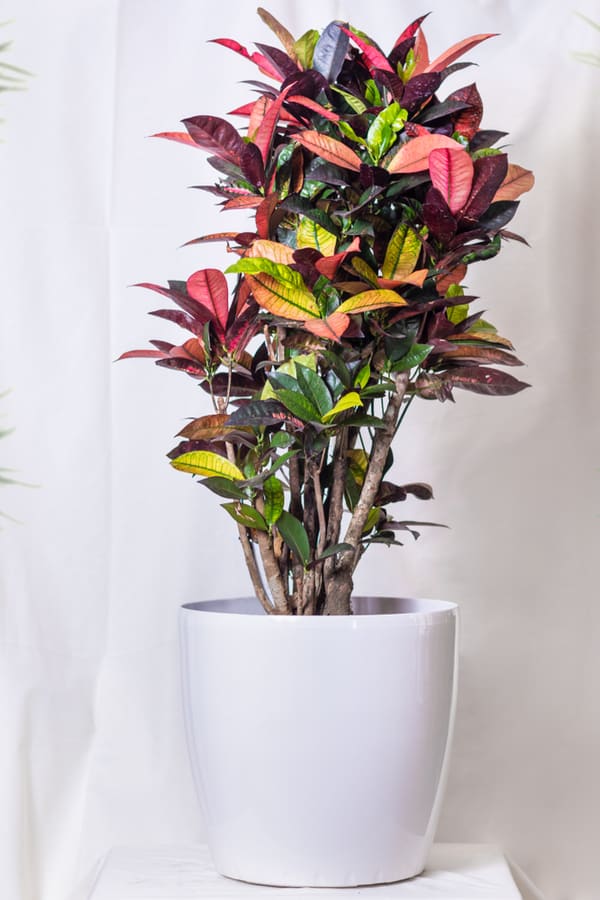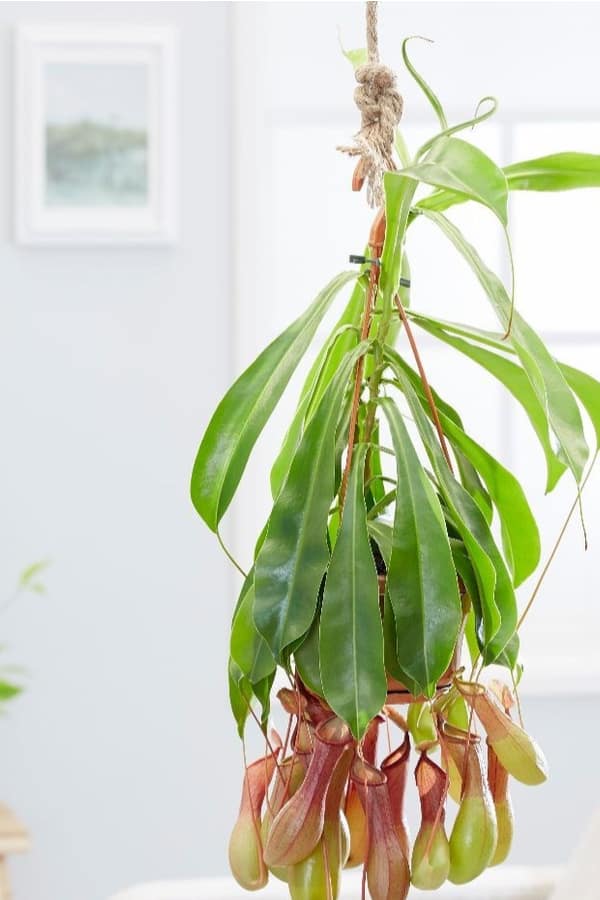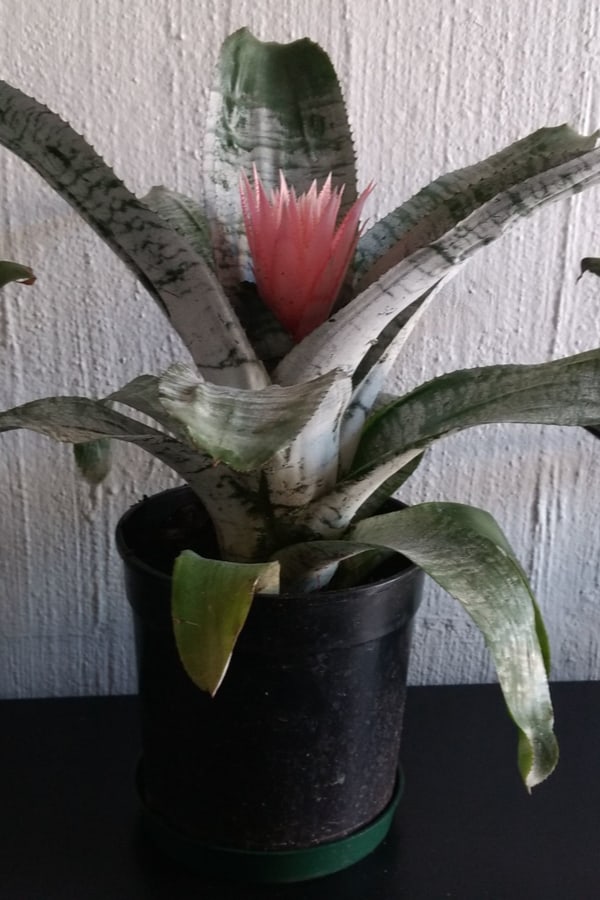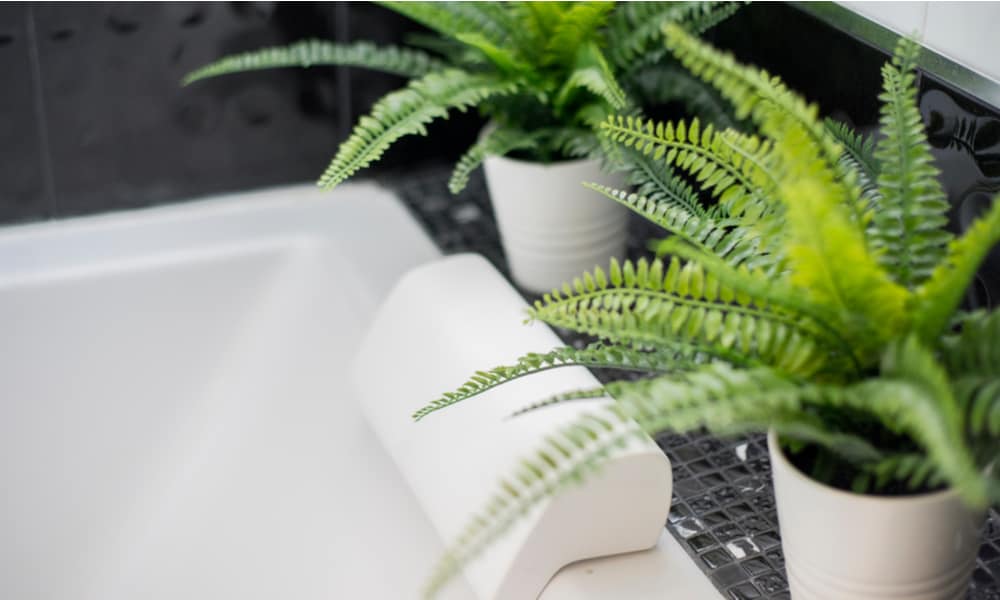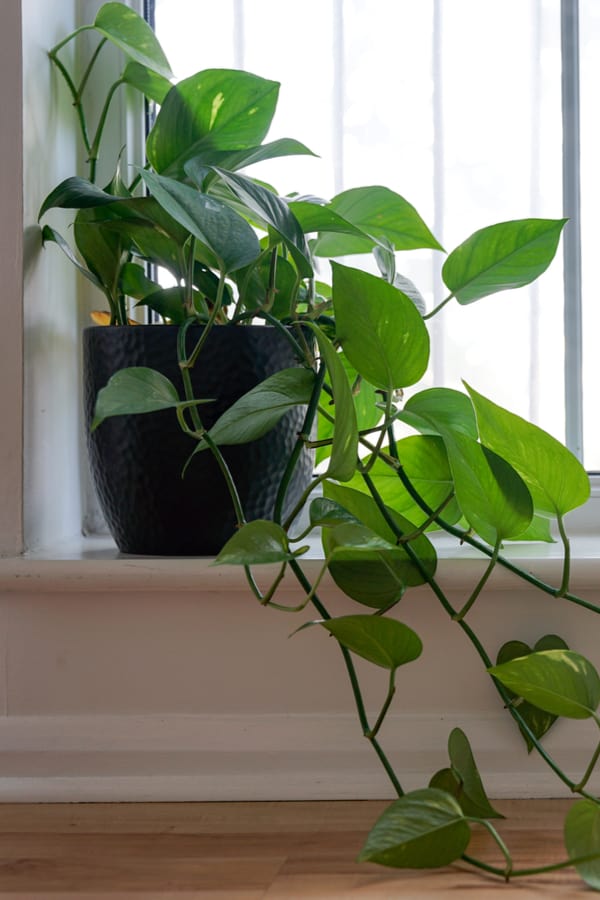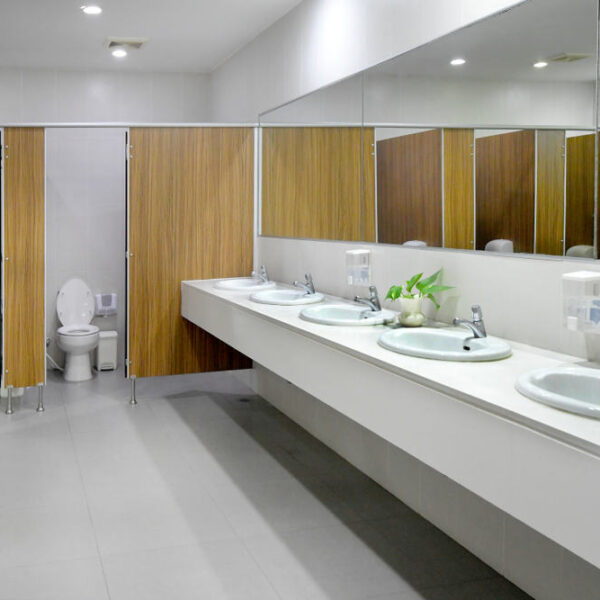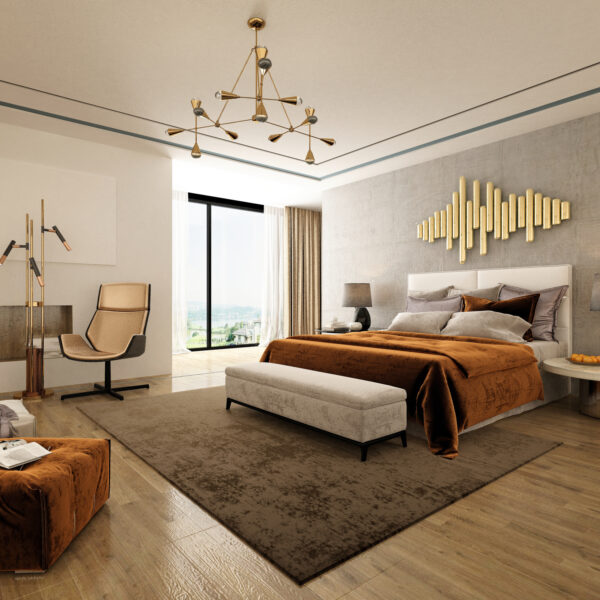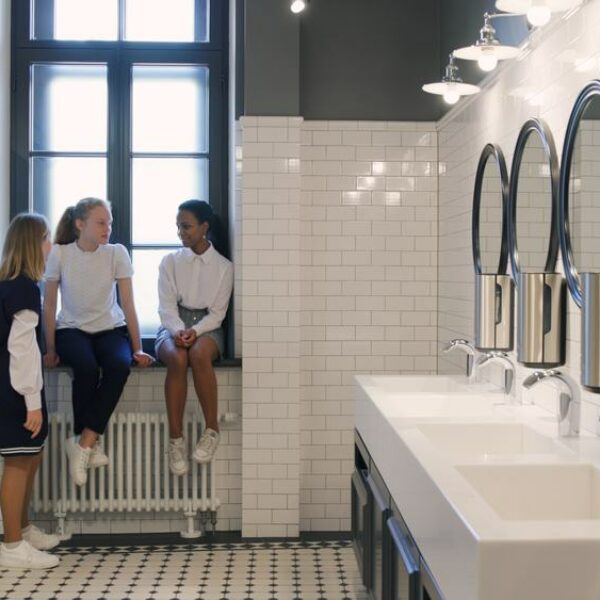In some ways, plants feel like a natural fit for the bathroom. Just think – all that glorious water! In other ways, it seems like a bad idea. After all, the soil from your plants will constantly smudge your spotless tiles and glossy floors. Still, lots of people love watching greenery while they bathe.
The type of plants you invest in should survive in low light, because many bathrooms have small windows. Some have no windows at all, or have windows that are smoked, tinted, or textured for added privacy. Your plants also need to safely withstand humidity. Here are 21 examples.
1. Fiddle-leaf fig
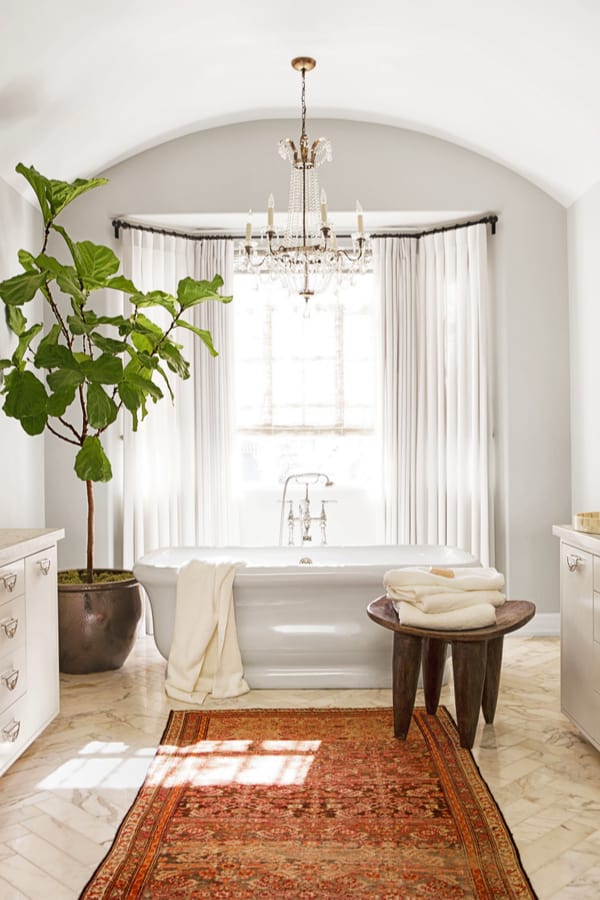
Some say this plant is pretty fussy. It loves humidity, so the steam from your bath bombs and showers won’t kill it. But it reacts to other extreme conditions, whether it’s too hot, too cold, too wet, or too dry, which cancels out its ‘low maintenance’ reputation.
It can get really tall, so you may have to prune it for size control if you have limited bathroom space. It’s luscious and beautiful, but you’ll probably need a thermostat to maintain suitable temperatures. Elsewhere in the house, a humidifier will do, but here, daily showers are fine.
2. Spider plant
Some varieties of spider plant are used as an edible vegetable, especially in parts of East Africa, where it’s better known by its local name, sagaa. That’s not the kind of spider plant you want in your bath. Instead, you want the more decorative type, with variegated leaves.
Direct sunlight can harm these plants by scorching their leaves, so they work well in the indirect light of a bathroom whose windows are darkened. It grows fast, so it needs a new pot every year. It’s great at absorbing bathroom smells and VOCs (especially formaldehyde) so that’s a plus.
3. Begonia
They’re a great way to add some color to your bathroom, because they produce the most beautiful flowers. They need a lot of light though, preferably indirect light. So you want windows and skylights for your begonia bathroom. You can supplement with daylight-simulation lamps.
Fluorescent lights seem to work too, though if the bathroom isn’t used every day, you’ll have to mist your plants to keep them healthy. If you place the plant at the window, the glass should be stained, tinted, smoked, or textured to filter potentially harmful sunshine.
4. Bamboo
The ultimate tropical stereotype, bamboo is at home in any bathroom or wet room. It grows tall, so it’s best for vertical placement, and you’ll need lots of space. Bamboo is a reed that – in its natural form – grows out of water, swamps, and marshes. Meaning it needs constant hydration.
Some varieties – such as lucky bamboo – can be planted in a tall trough, bottle, vase, or pitcher filled with anchoring pebbles and water. No soil needed, so less mess for your tile floors. Change the water twice a month though, and shape your bamboo plant to control its height.
5. Orchid
The small size and pretty colors of this plant make it ideal for a neutral-toned bathroom. Even if the window is small and/or translucent, the orchid will thrive. It actually prefers indirect sunlight, so this works out well. But if the room is too dark, your flowers will wilt.
Supplement darker bathrooms with daylight bulbs, but know orchids require indirect solar rays to stay alive. Some orchids prefer brighter (but still indirect) sunlight. Orchids have few leaves, long stalks, and blooming flowers. You can plant them in tree bark if you don’t want to use soil.
6. Peace lily
The distinct ‘flowers’ on a peace lily are a variation of hooded leaves (called leaf bracts). The actual flower is a tiny bulb-like growth inside the white leaf bracket. The plant also has dark, glossy leaves that look great in a shimmering tiled bathroom. It ‘cleans’ the air of VOCs.
Peace lilies are especially good at clearing benzene from your bathroom. It doesn’t need much light, but the more light you have, the more white ‘flowers’ it produces. If your lily leaves droop, they’re too dry, so spray a light daily mist, but don’t pour on the liquid – overwatering kills lilies.
7. Aloe vera
This magical plant barely needs watering – the steam from your shower will keep it hydrated. And if you’re in a bind, you can pluck off one its succulent leaves, scrape the surface to expose its healing juices, then rub them on a bite, cut, sunburn, rash, or scald. It’s instantly soothing.
It’s also effective in detoxifying VOCs. There are many aloe vera varieties, so pick one that matches your bathroom aesthetic. As a succulent, excess heat can harm its leaves, so stick with low-lit windows, offering your plant indirect sunlight. Then leave it alone and just let it grow.
8. Azalea
You may not want Iggy in your bathroom … (or maybe you do!) And given the amount of care they need, azaleas are iffy as a bathroom plant. But their beautiful hues, luscious petals, and soothing scent make it worth the effort. They do well with humidity, so don’t (over) water them.
They also prefer cooler areas, so indirect bathroom light works well. Outdoors, azaleas are shaded and mulched to control sunlight and moisture loss. Both these requirements are naturally met by the average bathroom. A little daily sun is good though, for better blooms.
9. Dumb cane
Sometimes known as dieffenbachia, this hardy plant does well, with or without your attention. It can survive the high humidity of a high traffic bathroom, but can live in your little-used guest bath too (water it once a week in unused bathrooms). Avoid children’s bathrooms though.
Why? The fluids from dumb cane can be poisonous, so it’s likely to harm curious kids and scratchy pets. Wash your own hands each time you water or wipe your dieffenbachia leaves, or you may accidentally spread or ingest toxins. Rotate the plant monthly for even light exposure.
10. Weeping fig
Some decorators recommend this plant, but it can give you a lot of unwanted tears. It can take humidity, but not too much, so you might need to accessorize your bathroom with a dehumidifier if you use it a lot – or if the whole family shares the same shower space.
And it needs bright light, so you can only grow it in a bathroom with large sun-facing windows. Also, the plant is bothered by sudden temperature changes, from steamy showers to open-window drafts, meaning you need a thermostat … so weeping figs may not be worth the hassle.
11. Dragon plant
It’s not quite Dracarys, and Dracaena plants need their ‘fire’ constantly quenched. They’re best for shared showers, because the moisture is always flowing. For less popular bathrooms, you’ll need to water the plant a lot, or else it’ll dry up and its leaves will brown. Also, it needs shade.
Bright sunshine can scorch its leaves, and this ‘dragon’ seems ironically averse to heat and strong light. It may be more of an ice dragon. But as long as it’s kept cool, grown in low light, and given lots of water, it’s great for air purification and comes in lots of color options.
12. Pothos
No relation to Athos or Aramis, Pothos are sometimes called Money Plants. They come in many styles, and you’ll hear myths about feeding it with coins or used tea bags to help this trailing plant climb higher. It’s a low-fuss plant that doesn’t need much attention, but you can ‘train’ it.
In some homes, it can curve right around the room, following a string, stake, or waterproof wire. It works well in a hanging basket, and is at peace with low light and high humidity. It does need regular pruning though. Otherwise, you’ll soon have a mad, unruly creeper bush.
13. Eternity plant
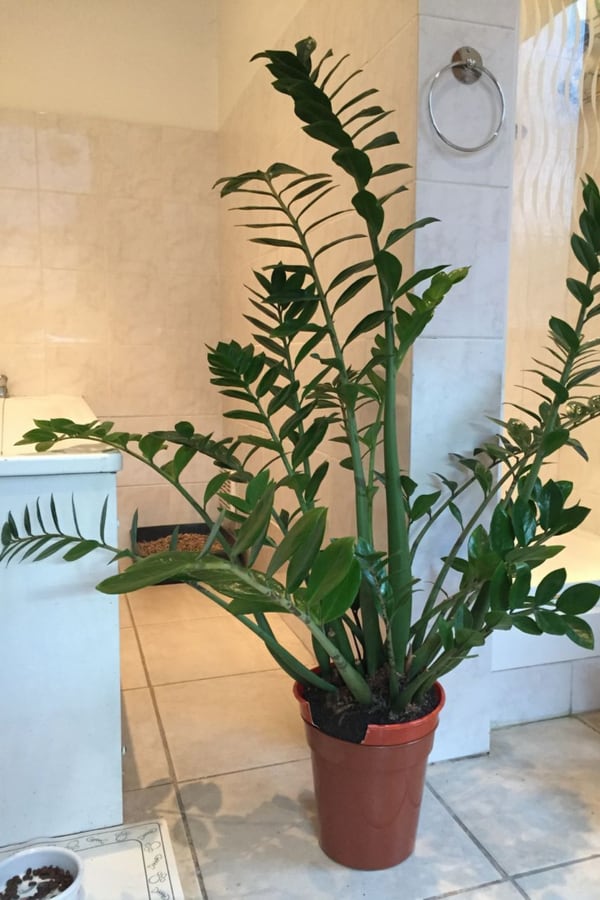
Lots of people just call it the ZZ Plant or Zee Zee plant, because its scientific name is Zamioculcas zamiifolia. This pretty plant loves water, and will start to shed leaves if it gets too dry. It thrives in most conditions, which is why people call it the Eternity plant.
That said, it enjoys high humidity and moderate, indirect light. You can use daylight lamps, skylights, or solatubes to supplement sunshine. Zee Zee leaves grow thick and dark, and have an attractive gloss to them. They fan out in fronds, and the plant can grow two feet high.
14. Ivy
This isn’t the poisonous kind. It’s the NASA-approved kind. They’ve declared it one of the best plants for air purification. If you’ve read or watched experiments about of floating feces in your bathroom, you’ll want one of these. It sucks human waste and other toxins right out of the air.
English Ivy is especially favored, but all ivies are creeping evergreens that look good in hanging baskets, or trailing along the walls and up your pipes. Ivy wants high humidity and moderate light levels. It doesn’t need watering in a frequently used bathroom.
15. Snake plant
This long-leafed plant is better known as Mother-in-Law’s Tongue, and its edges and pointy tips can be quite sharp. It’s a good detoxifier, especially formaldehyde and other volatile organic compounds (VOCs). Its stiff leaves grow up and out, so it doesn’t need much horizontal space.
It also doesn’t use up much water or require a lot of sunshine. It’s not adversely affected by humidity, and will help you soak up the fumes and toxins from your bathroom (and beauty) products, including detergents. It needs little to no plant care – maybe occasional dusting.
16. Cast iron plant
Visually, cast iron plants are diverse. It could be anything from dark green to striped or speckled yellow. They handle heat well – up to 85ºF, and prefer humid bathrooms with indirect light. Depending on your bathroom size, you could plant an 18-inch dwarf or a 3-foot full-sized one.
These iron-willed plants will be fine, even if you never pay attention to them. Which is why they’re ideal for guest baths. But if the bath is not used often, remember to water the plant at least once a week. And if you can, keep temperatures above 50ºF.
17. Croton
This colorful plant needs room to spread. It can reach three feet in height, and its leaves can stretch just as far across. It offers good aesthetics, with its range of colored, variegated leaves. Soil should stay moist, so bathroom humidity is suitable. It wants lots of light, but not directly.
When your croton is unhappy, it will fade and shed. This could mean your plant is too hot, too cold, too wet, too dry, or too shaded. Use a humidifier with a thermostat to maintain a temperature of 50ºF to 70ºF, and keep cool drafts away from your bath plant.
18. Monkey cups
Their other name is Tropical Pitcher plants, because they have a gourd-like ‘flower’ mechanism that looks like a pitcher. They use this ‘monkey cup’ to eat … insects … so it’s a great way to keep pests, fruit-flies, and bottle-flies out of your bathroom. It needs damp soil, so humidity is good.
Some monkey cup owners buy insects for their plant, but you don’t need to – there are enough bugs in the average apartment to keep a single plant sated. The steam from your shower or tub will keep the soil sufficiently moist. Plus, monkey cups come in lots of pretty shapes and colors.
19. Bromeliad
There are lots of different bromeliad sub-species, but they all thrive in bathrooms because of the high humidity and indirect light filtered through discreet bathroom windows. This may be stained glass or smoky, textured window panes. Plus, bromeliads have brightly colored blooms.
Meaning their bathroom advantage is style. With so many varieties, and with each one having such variegated leaves and vibrant flowers, you’re sure to find one that matches your bathroom color scheme. Even better, they don’t need much attention or frequent watering.
20. Fern
Some interior decorators recommend moss as a bathroom plant, because it gives your home a plush, green look, pun intended. But if you’re not ready to go that far, plant some ferns in peat moss. Their leaves grow quite long, so your ferns will need lots off space and humidity.
Use a basket rather than a pot, and ensure your plant stays moist. Both the fern and the moss underneath prefer filtered bathroom light. Every month, take your fern basket – with the moss and ferns still in it – and soak it in water. Drain out the excess water and you’re good.
21. Philodendron
The curvy leaves and glossy green of philodendrons are a joy to look at. They can live with even the tiniest amount of light, and will curve towards its source, so it’s best to place them by the window. While they can go weeks without watering, humidity doesn’t harm them.
In the wild, philodendrons grow on the jungle floor, surrounded by dense canopies and thick brush. If they get too much light, they turn yellow. If they get too little, their leaves spread far apart in search of separate light sources. Add (or remove) artificial light sources accordingly.
Water water everywhere!
We assume a bathroom is a flood zone for plants. In reality, your water is restricted to your tub, sink, or toilet, so it rarely touches the plants themselves (unless you have a wet room). Instead, the room stays humid from all the steam, meaning you won’t have to water your plants much.
Like many other plants, excess watering can kill them, so stick to daily baths or showers and keep your plants happy. Wipe their leaves to prevent accumulated dust, which may clog their pores. Do you have plants next to your tub? Share your bath-plant selfie in the comments!
